Suomi.fi Web Service History
Suomi.fi Web Service’s task is to help citizens and entrepreneurs in different situations. The information, instructions and services you need to take care of matters have been compiled in one address. Suomi.fi also includes national services for identification, electronic communication and authorisation.
We have compiled information on Suomi.fi's predecessors and key achievements on this page. We will complement the page as Suomi.fi develops as the years go by.
Suomi.fi's story continues and becomes complemented!
Over the years, many people have participated in the development of Suomi.fi. If you have facts, anecdotes or memories from Suomi.fi, you can send them to us as pictures, videos or text at dvv.viestinta[at]dvv.fi.
From the Citizen's handbook to the first joint electronic transactions services (1992–2009)
The Suomi.fi web service was officially opened on 4 April 2002. However, the content history of the Suomi.fi service extends until 1992.
What was the Citizens' handbook and how was the Suomi.fi service and web editors originally established? And what were the first joint electronic transactions services like?
The Citizen's Manual was published in Finnish from 1992 onwards and in Swedish from 1993 onwards, bringing together the information of public services required by the citizen in different life events.
A website was published on the handbooks in 1997. The Ministry of Finance was responsible for the planning of the guide. The Citizens' handbook and its website were replaced in 2002 with the Suomi.fi Web Service.
Images: The Citizen's Manual
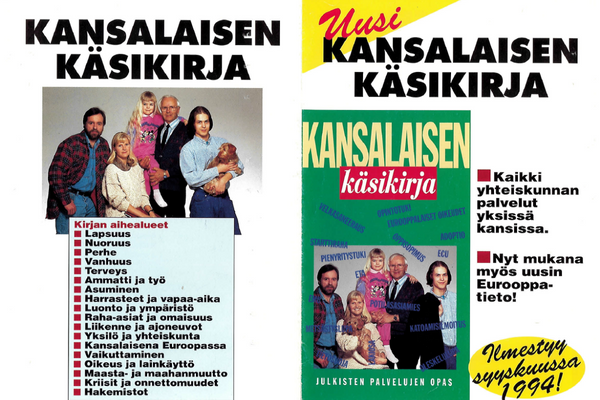

The Suomi.fi web editorial team was established in the Government Information Management Unit in 2002.
The Suomi.fi service was opened on 4 April 2002. The first Suomi.fi service consists mainly of links to public administration services. The links are grouped by topic (for example, Living and Family or Culture and Leisure).
Suomi.fi and the web editors were transferred to the Government IT Shared Service Centre established in the State Treasury in 2009. In 2017, Suomi.fi and the web editors were transferred to the Population Register Centre (starting in 2020, the Digital and Population Data Services Agency).
Screenshot of Suomi.fi in 2002
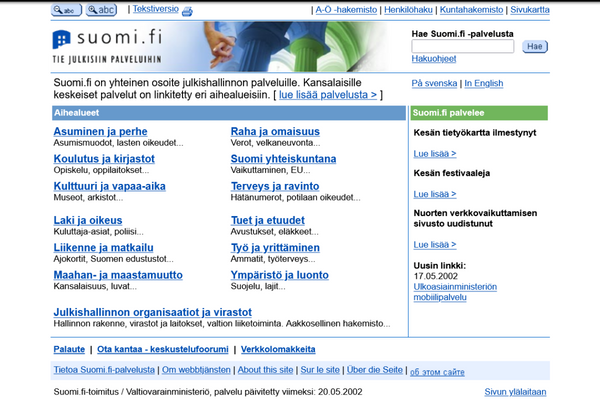
The Lomake.fi platform was published for pilot use.
Lomake.fi is the first platform shared by the administration for producing e-service forms. In the early stages, the platform contains simple forms that can be used without identification or by using an HST card.
Simple e-services implemented on the lomake.fi platform are also linked to the Suomi.fi service, where users can find them.
The Yrityssuomi.fi (Enterprise Finland) service was opened. The service is intended for companies and those considering entrepreneurship – similar to Suomi.fi is intended for citizens. The PKT Foundation is responsible for developing the service, and the Ministry of Trade and Industry steers the development of the service.
In addition to Entreprise Finland website, there is a telephone service. The Enterprise Finland Telephone Service provides assistance for new and well-established businesses. It can be reached on +358 (0)295 020,500.
Screenshot: Enterprise Finland in 2002
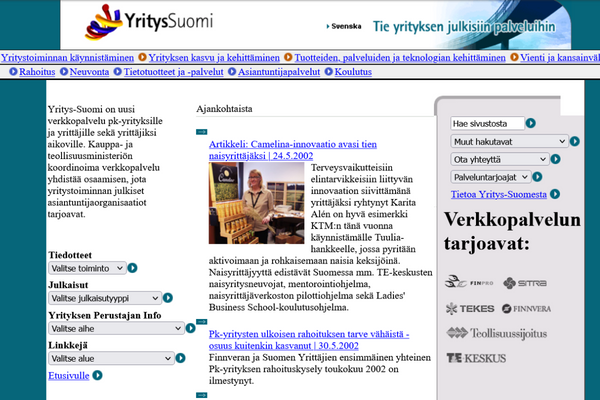
The Otakantaa.fi concept was developed by the Ministry of Finance in the Administration Development Department, and its trial use began in 2001-2002. The website was published in 2003 and later became part of the Suomi.fi family.
Otakantaa.fi was transferred from the Ministry of Finance to the Ministry of Justice in 2005. In this case, it became part of the wider family of democracy services in Suomi.fi (demokratia.fi).
Screenshot: otakantaa.fi in 2003
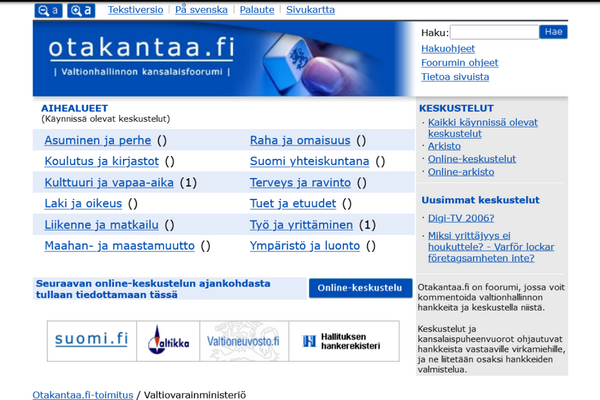
Asiointiopas.fi is published as a new service in Suomi.fi family, as a guide for the use of administrative web services and electronic business.
Screenshot: asiointiopas.fi in 2004
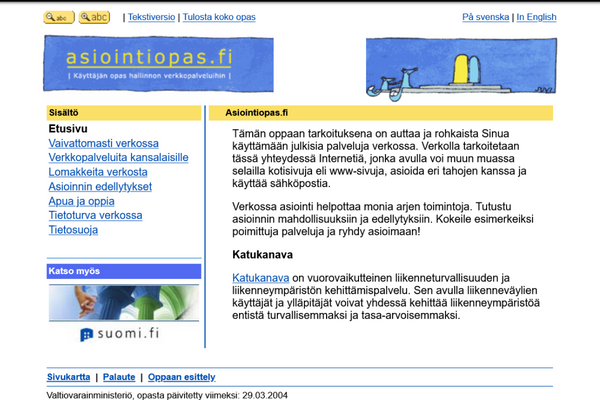
The Laatuaverkkoon.fi service provides tools for developing and evaluating the quality of public online services. One of the tools is a set of quality criteria that defines the characteristics of a good public online service. An assessment tool based on criteria can be used to assess the quality of the online service and identify areas for development.
The criteria were developed in a cooperation project set up by the Ministry of Finance.
The updated version of the quality criteria and the assessment tool was opened in the Suomi.fi service in spring 2008. In 2022, the completely renewed Suomi.fi Quality Tools opened.
Image: laatuaverkkoon.fi in 2004

Planning of the online identification and payment service for citizens (predecessor of Suomi.fi e-Identification) began in 2004 at the initiative of the municipalities in the Helsinki Metropolitan Area.
The aim of the project is to acquire a common platform for online identification and payment for public administration use. The service enables citizens to identify themselves in public e-services and pay online. The service was introduced in stages in 2006.
At the end of 2017, Suomi.fi e-Identification replaced the Vetuma service in its entirety.
The Tax Administration publishes the identification and authorisation services of companies at Tunnistus.fi and Katso.
The Suomi.fi e-Identification replaced the Katso service by the end of 2017. Use of Katso service was discontinued in 2021, when the service was replaced by Suomi.fi e-Authorizations
Nowadays, the user always uses Suomi.fi e-Authorizations to log in to public e-services as themselves and, if they so wish, act on behalf of a company, organisation or another person.
The objective of the Services Directive is to promote the free movement of services within the EU and the relocation of businesses in another Member State. The Services Directive obliges EU Member States to establish one-stop shops, through which the founders of a company can find all the necessary information about starting a business.
Yrityssuomi.fi became Finland's one-stop shop in 2007. In 2011–2013, Yrityssuomi.fi collected data on permits, notifications and registrations required in different industries. The information is compiled in working groups involving representatives of the agencies issuing business permits.
Under the Professional Qualifications Directive, professional qualifications required in Finland are also collected in Yrityssuomi.fi.
Yritys-Suomen ohella toimii puhelinpalvelu. Yritys-Suomi-puhelinpalvelu neuvoo yrityksen perustajia ja toimivia yrityksiä eri tilanteissa. Puhelinpalvelu palvelee numerossa 0295 020 500.
Time for reforms (2009–2014)
The Government IT Shared Service Centre was established in the State Treasury, and Suomi.fi and the online delivery was transferred to the new home. The foundation for the development of Suomi.fi towards a common online service platform was created.
But why on earth did they need legos? And what was the Citizen's Account and the Kuntapuntari?
The Suomi.fi service and web editors were transferred from the Ministry of Finance to the newly established Government IT Shared Service Centre, the State Treasury. The Government IT Shared Service Centre also produces the Lomake.fi platform and Vetuma identification and launches the procurement of a citizen's account.
Suomi.fi's entire user interface was renewed. Municipal services and service channels became a permanent part of the Suomi.fi Web Service. The Suomi.fi service is now using the legendary Virtual Vertti, which provided advice and guidance on how to use the service.
Screenshot: Reformed Suomifi in 2010
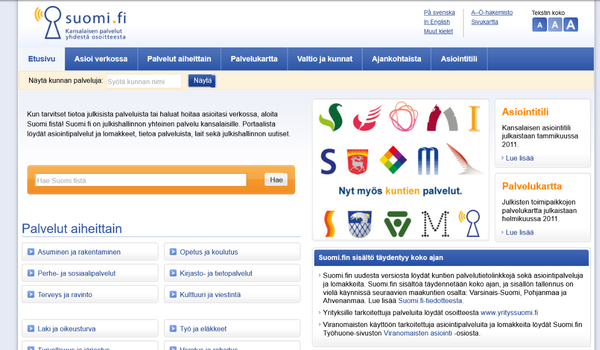
The map service for public service points was designed as part of the Suomi.fi service in 2009–2010, and the National Land Survey of Finland was involved in providing the administration map service.
The first service map was published as part of Suomi.fi in autumn 2010. Later, the Suomi.fi Maps service was integrated as an integral part of the Suomi.fi Web Service during the National Architecture Programme, and it was also be renamed as Suomi.fi Maps services.
Yrityssuomi.fi was transferred from the PKT Foundation to the State Regional Administration Information Management Unit (AHTi) in 2010.
The completely reformed yrityssuomi.fi was published in 2011. In 2015, AHTi was integrated into the development and administrative centre of ELY Centres and TE Offices. The development of the service is steered by the Ministry of Economic Affairs and Employment.
A new concept for the Suomi.fi service was created in a project that continued from autumn 2011 to spring 2012, in which the administration, NGOs and citizens were consulted.
The background memorandum of the concept already described, for example, the current Suomi.fi Finnish Service Catalogue, the Messages service and service collections tailored to individual users, which are currently implemented in the national AI project AuroraAI.
The website for regional business services was implemented in Yrityssuomi.fi, through which users can find business services in their area. Information is maintained and updated by regional contact persons.
The Kuntapuntari campaign was launched. The campaign attracts municipalities to describe electronic services as part of the Suomi.fi service.
On the campaign website, the public were able to compare municipalities with the municipal guarantee theme ("our municipality has more electronic services than you in the neighbouring municipality").
The State Treasury's IT Shared Service Centre published the Citizen's Account on 28 January 2011 as part of the Suomi.fi Web Service.
The Citizen's Account is a secure electronic communication service between the public administration and citizens. The development of the Citizen's Account is part of the SADE programme (promiting electronic transactions and democracy) of the Ministry of Finance.
The Virtual Vertti also guides citizens in using their Citizen's Account. The functionalities of the Citizen's Account have now been replaced by Suomi.fi Messages.
Image: Citizen’s Account and Virtual Vertti in 2011
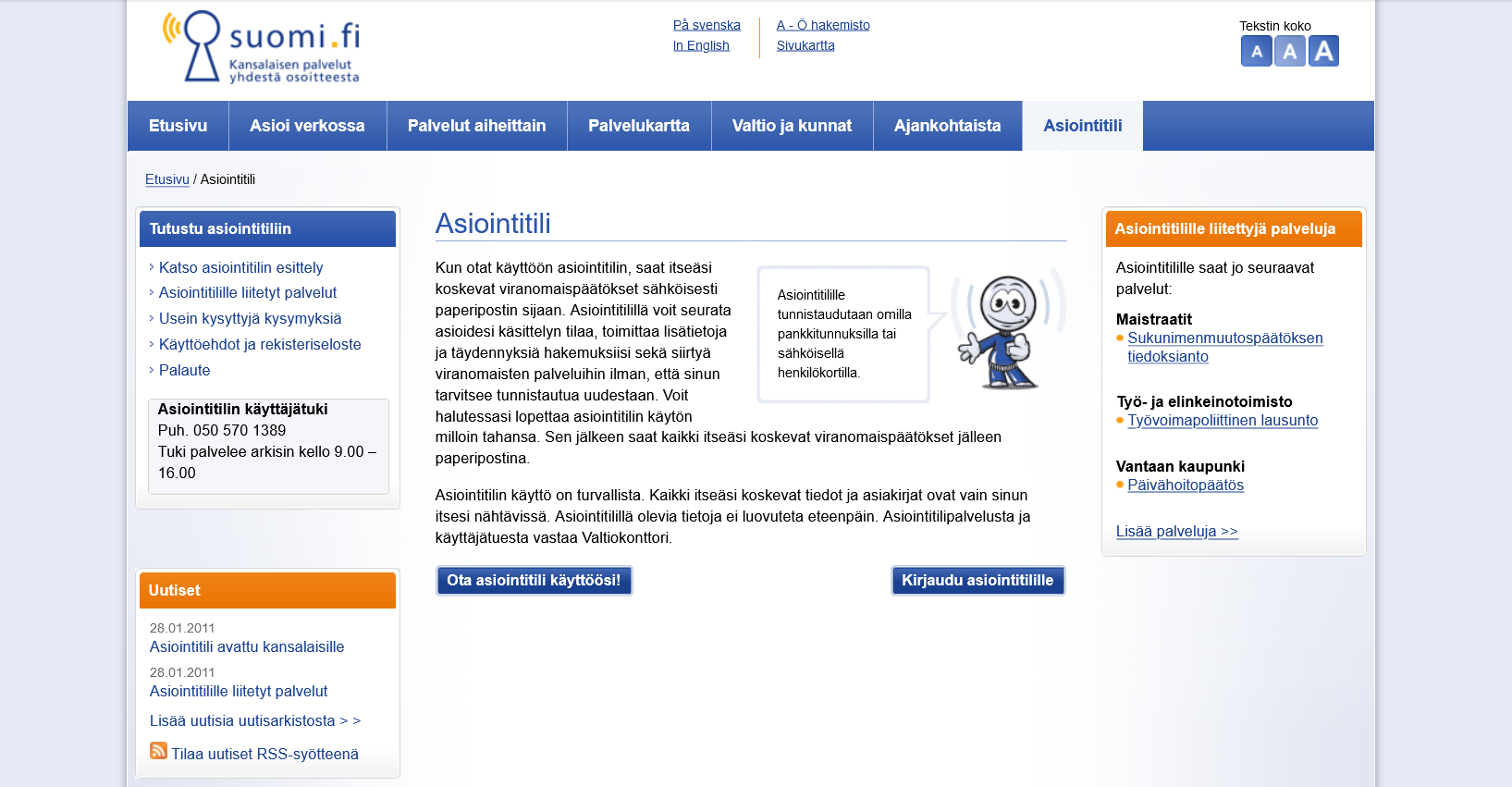
The State Treasury's IT Shared Service Centre's Suomi.fi web editors and experts meet in Lappeenranta to plan the future of electronic services and learn the model of agile development.
As a result, the Ministry of Finance was presented with a future electronic service model based on legos. In the template, the user is placed at the centre of the services. Many of the services of the Lego House were implemented later as part of the National Service Architecture Programme.
The State Treasury's IT Shared Service Centre opens the Public Service Info l The development of the service is part of the SADE programme (promiting electronic transactions and democracy) of the Ministry of Finance. The Public service Info was later transferred to the Population Register Centre (currently the Digital and Population Data Services Agency).
Public Service Info provides guidance and advice to the right public services and supports users in using Suomi.fi services. The service functions as a telephone service (0295 000) and in various electronic service channels (form, chat). Public Service Info currently responds to citizens' contacts more than 100,000 times a year.
When the coronavirus pandemic started in 2020, the National Public Service Info also opened COVID-19 advisory services and later the user support for the Koronavilkku application. The advisory services were later discontinued as the need for advisory services decreased.
My Enterprise Finland was opened: My Enterprise Finland offers tools for those planning and operating as entrepreneurs, for example, to prepare a business plan and a business development survey.
Suomi.fi develops into Central Government’s Joint e-Service Support Services (2014–2019)
The entirely new Suomi.fi services was developed in an agile and user-oriented manner in the National Service Architecture Programme, and separate legislation was laid down on their use.
Suomi.fi services became a critical part of Finnish digital society. Services are rewarded in Finland and abroad, and awareness of Suomi.fi services is increased among citizens.
But what is Straumurinn and why is the green button an important part of history?
The ICT 2015 working group appointed by the Ministry of Economic Affairs and Employment makes a proposal for building a national service architecture, as it had identified the need to facilitate the creation of services across organisational boundaries, to avoid overlapping work and to improve customer service. In its decision of 19 November 2013, the Cabinet Committee on Economic Policy advocates that the Ministry of Finance appoint a national service architecture implementation programme and a cross-administrative steering group for it.
The responsibility for implementing the programme is assigned to the Population Register Centre (starting in 2020, the Digital and Population Data Services Agency). The programme implements four projects:
- e-Identification
- Service outlook
- Roles and authorisations
- Data Exchange Layer
The end result of the programme is the current Suomi.fi services: e-Identification, Suomi.fi Web Service, Suomi.fi Finnish Service Catalogue, Messages, e-Authorizations and the Data Exchange Layer.
The KaPA programme has a budget of EUR 100 million, but the implementation of the programme eventually costs EUR 70 million, which is significantly below the budget, which is not necessarily very common in the digital projects of public administration. The saved money continue the development of Suomi.fi services in 2018–2019.
A new identification service was opened. With the identification service, all contracts and expenses are handled centrally at the Population Register Centre. All public services were obligated to switch to the identification service by the end of 2017.
Nowadays, all public administration electronic services are identified through Suomi.fi e-Identification. Today, there are more than 200 million identification events each year.
Finland and Estonia conclude a 2013 agreement on the introduction and utilisation of X-Road technology developed by Estonia in Finland. The contract was concluded by the then prime ministers of the countries.
Suomi.fi Data Exchange Layer and the API Catalogue opens for production use in 2015 with a solemn push of a button.
Image: The green button of the Data Exchange Layer and a PostIt label, which reads: "Production reboot. DO NOT PRESS!"
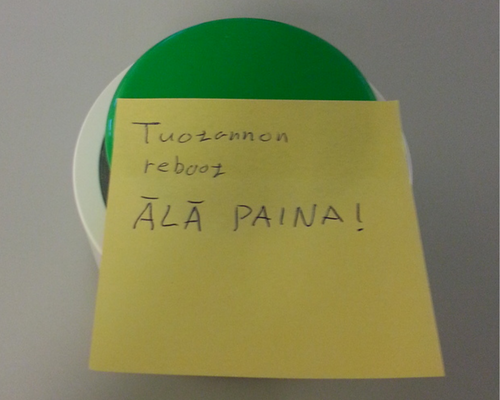
Data Exchange Layer provides a standardised method for transferring information between the data systems of private and public sector organisations (and countries). Organisations can utilise the standardised data provided by the Data Exchange Layer and bring it to the service itself by integrating it into the Data Exchange Layer. The Suomi.fi Data Exchange Layer is based on X-Road technology developed in Estonia. The Population Register Centre implements the Finnish version of the Data Exchange Layer.
X-Road technology is currently being developed by NIIS (Nordic Institute for Interoperability Solutions), jointly funded by Finland, Estonia and Iceland. In Iceland, by the way, the Data Exchange Layer is called "Straumurinn", which means power and describes the idea of the service well.
The beta version of the Suomi.fi service was published. The old Suomi.fi service continued as a production version, and feedback and development ideas were collected on the new version.
In autumn 2016, Mikrobitti selected a new beta version of the Suomi.fi service for the Service of the Year.
Legislation was drawn up on the Suomi.fi services developed in the KaPA programme (Act on Government’s Joint e-Services), which was approved by Parliament in summer 2016. The Act obliges public administration actors to use free Suomi.fi services.
Some of the services (e-Authorizations, Data Exchange Layer, Suomi.fi and the Suomi.fi Finnish Service Catalogue) are also offered free of charge to the private and third sectors.
The Act was updated from the beginning of 2019, when it was possible to register e-Authorizations by parties other than the Digital and Population Data Services Agency, i.e. the so-called authorisation service for officials. This also enables completely new ways of granting authorisations to, for example, customers without digital skills.
Suomi.fi Finnish Service Catalogue was opened. Suomi.fi Finnish Service Catalogue (FSC) is a national centralised data repository in which municipalities, central government and the private sector describe their services and service channels in a customer-oriented manner.
The Finnish Service Catalogue contains open data, which means that it can be accessed across a public interface from anywhere else, such as from online services, chatbots and map services. All content described in the FSC is also displayed in Suomi.fi Web Service.
The Suomi.fi Finnish Service Catalogue also includes an accessibility information application that was originally developed by the City of Helsinki.
The FSC is based on a common EU-level data model (CPSV-AP, Common Public Service Vocabulary Application Profile). The father of the FSC's idea, Marko Latvanen, outlined the description of the FSC's data structure in the dirty wall of the basement of the circle house in Hakaniemi, Helsinki in 2011.
In summer 2019, the Suomi.fi Finnish Service Catalogue was awarded the EU Sharing & Reuse competition as one of the most innovative digital services in the EU.
Suomi.fi e-Authorizations were opened. Suomi.fi e-Authorizations provides a reliable and real-time way of verifying a person's, company's or organisation's mandates and rights to act electronically on behalf of another person, company or other organisation. In Suomi.fi e-Authorizations, private persons, companies and organisations can also authorise someone else to act on their behalf.
The use of authorisations has increased strongly in 2017–2022, and the growth continues at a rapid pace. Citizens have already created over 30 million electronic power of attorneys in the Suomi.fi service (situation in autumn 2022).
In summer 2019, the Suomi.fi e-Auhtorizations was awarded the EU Sharing & Reuse competition as one of the most innovative digital services in the EU. In the same year, the National Blue Arrow Award was also awarded as a digital service that provides the most societal benefits.
A common brand and visual identity was created for all Suomi.fi services. To support the development of the services, the Suomi.fi - Design System was developed, which will be used to standardise the user experience of the services and develop their usability and accessibility.
Nowadays, you can identify all Suomi.fi services with a service ID that resembles the Finnish flag.
The old Suomi.fi service was closed and the previously published beta version became a production version. The company section publishes the first path-like guides.
Suomi.fi Maps are opened. The Maps service is a joint map and geographic information system solution for public administration. Organisations can embed the Maps service on their own internal or external websites and thus create map services for their clients.
You can also attach your own spatial data that is available through the spatial data infrastructure to the service.
In the national service architecture programme, the Population Register Centre and the National Land Survey of Finland also produced Finland's first more accessible map material, the so-called Selkokartta map.
Today, the maps can also be used to select a map view specifically intended for users with accessibility issues. This is particularly beneficial for visually impaired or users with cognitive problems. It was also a rare development effort on a global scale.
Screenshot of Suomi.fi's Selkokartta
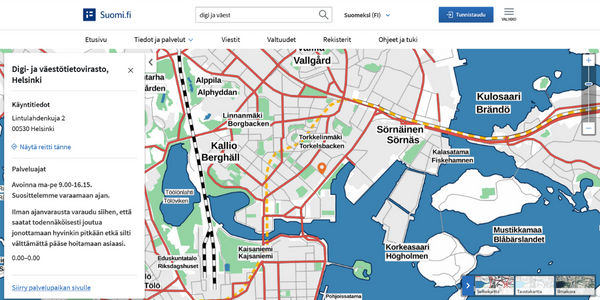
Suomi.fi Messages is opened and it also replaces the old Citizen's Account. Suomi.fi Messages is a reliable way for citizens and companies to communicate with authorities and other organisations using the service.
The introduction of Suomi.fi services was made easier by developing the organisations’ self-service Suomi.fi Service Management. Self-service enables organisations to apply for user and data permits, manage services and view service usage statistics.
The old Suomi.fi was closed and the previously published beta version became a production version. At the same time, the old Enterprise Finland was closed and the new Suomi.fi service also replaced it.
At the beginning of the year, Suomi.fi online editorial staff was transferred from the State Treasury to the Population Register Centre (currently the Digital and Population Data Services Agency) to the Suomi.fi web service, which was renewed in the KaPA programme.
Later, the network suppliers of the Yrityssuomi.fi service were also transferred to the Population Register Centre.
The Suomi.fi mobile application is published in app stores (IOS and Android). The mobile application can be used to access Suomi.fi Messages, i.e. receive electronic messages from authorities and respond to them if necessary.
Image of the Suomi.fi mobile application

Yrityssuomi.fi was closed and replaced by the Suomi.fi company section. Web editors of Yrityssuomi.fi were also transferred to the Population Register Centre.
You can browse videos in sign language in the online service guides on your own dashboard. The route search of the online service map was made accessible, and the presentation of service and guidance information was developed on the basis of customer feedback.
The search engine discoverability of the Suomi.fi Web Service and its own search was improved over the long term. You can familiarise yourself with authorisation themes without strong identification.
Suomi.fi services was expanded and new services and features were developed (2020–)
Suomi.fi services was expanded quickly and entirely new services and features were developed. The future of Suomi.fi services as a common platform for electronic services is beginning to take shape on a completely new level.
The Suomi.fi web editors develop new operating models and invents sihards. But what on earth are they?
The Suomi.fi web editorial staff develops a content production model in which new guide content is built in cooperation with the public, private and third sectors. The idea is to provide people with content and services related to their life event.
In the development work, support for producing new kinds of guides was implemented in the content production system. The new guides are internally referred to as 'sihards', or 'wizards' published with a content management application.
The network service is transferred from the data centre to the cloud environment, which makes infrastructure maintenance straightforward, enables more agile updating and provides clear savings.
The Suomi.fi service provides organisations with an opportunity to apply for an electronic authorisation. The implementation is part of the replacement of the Katso identification service. The service enables assisted authorisations to companies and organisations that cannot independently grant electronic authorisations.
At the same time, a Finnish Authenticator intended for foreginers was introduced to enable foreign organisations to apply for electronic authorisations.
You can check the personal data stored in the Population Information System and make data disclosure prohibitions from Suomi.fi. You can also check the spouse's birthday if you have forgotten it.
You can also check how many inhabitants live in your own home according to the Population Information System.
The first guides are published for people and organisations who have been targeted by a data leak or data breach. The implementation is part of the measures taken by the Finnish Government in the aftermath of the Vastaamo data breach.
Several other guides based on life events have later been published in the Suomi.fi service.
The separate Katso identification service for companies will be closed after 15 years of use. In Finland, there is a shift to a service method in which the user always identifies themself and the e-Authorizations service produces data on the user's access rights on behalf of different organisations.
The service location information of the Suomi.fi Finnish Service Catalogue is integrated into the Suomi.fi Maps service. In this way, public administration actors can easily embed service maps in their own services with their own service information.
The Suomi.fi Web Service collects approximately one million visits per month. The new and more accessible homepage of the web service brings praise.
The authorisations are already used in more than 160 e-services and almost 370 different mandate themes.
The new Suomi.fi service was opened in spring 2022. Suomi.fi Quality Tools enable organisations to assess and develop the quality of their own digital services. The service is available free of charge for all organisations that have described the services in the Suomi.fi Finnish Service Catalogue.
Suomi.fi Quality Tools was included in the Tech for Government competition under the French Presidency of the European Union, where the service was finalised as one of the best examples of new digital public administration services.
In spring 2022, municipalities in the Kainuu Sote area tried registering authorisations for those without digital skills when visiting health stations. For example, an older person can authorise their loved ones to manage social welfare and health care services or pharmacy services on their behalf.
The tools developed by the authorities' officials for replacing the Katso service were used in the implementation.
The Digital and Population Data Services Agency opens an assisted authorization to people who do not have access to the digital services themselves or who do not have the necessary means of electronic identification.
The Finnish Institute for the Research of the Languages of Finland (Kotus) rewards the Suomi.fi web editors as a clear word user of 2022.
The winner of the competition was Minna Karhunen, Managing Director of the Association of Finnish Local and Regional Authorities. In her speech, she states that especially in difficult life events, people need clear and easily understandable information that helps them cope with practical matters. The Suomi.fi guides respond to this need. Another important reason for the selection is the new operating model used to produce guides.
Image: Minna Mäkinen, Anniina Väisänen and Terhi Tuokkola, the service owner of the Suomi.fi web editors, will receive the clear word user of the year award.
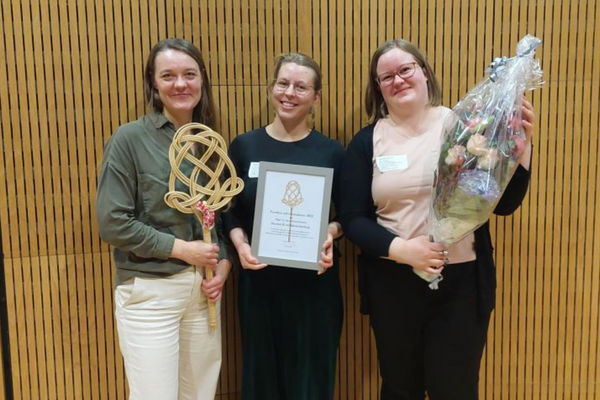
- Individuals
- Moving
- Check your own personal details
- Certificates from the Population Information System
- Names
- Guardianship
- Having or adopting a child
- Marriage
- Death and estate inventory
- Life changes while living abroad
- Moving while living abroad
- Registration of a child born abroad
- Marriage concluded abroad
- Partnership registered abroad
- Divorce granted abroad
- Registration of a name change performed abroad
- Death abroad
- Registration of citizenship
- Loss of citizenship of another country
- Notification of retaining Finnish citizenship
- Legalisation of foreign documents
- Submitting foreign documents
- As a foreigner in Finland
- Registration of a foreigner
- Guide for students
- Municipality of residence
- Family relationships and Marital Status
- Instructions on arriving in Finland from Ukraine
- Guide for employed persons
- Fast track service for specialists and growth entrepreneurs
- Instructions for legalisation
- Submitting foreign documents
- Foreigner’s move to Finland, in Finland and out of Finland
- Services of notary public
- Confirmation of gender
- Population information in the Population Information System
- Elections and Right to vote
- Certification of purchase
- Registration of a gift notification
- Citizen Certificate and electronic identity
- Organisations
- Certificates, cards, seals and stamps
- For social welfare and healthcare service providers
- For organisations
- Electronic sealing service
- Timestamping Service
- Electronic signature
- Service certificates
- Advisory service, support and revocation service
- Certificate Directory
- Test the use of a certificate
- Card Reader Software
- Information about certificates
- Population information services for organisations
- Public administration sampling and updating service
- Private sector information services
- PIS modified data interface
- Modified data update service
- Population Information System query interface
- Browser-based Population Information System query
- Resident selection service
- Selection service for municipalities
- Reform of personal identity code
- Conditions for using population information
- Selection service for wellbeing services counties
- Maintaining the Population Information System
- Extracts from registers
- Suomi.fi services
- Services to promote digitalisation
- Digital support
- Digital security services
- Services of notary public
- Certification of purchase
- Right to officiate weddings
- E-services
- Finnish Authenticator identification service
- Certificates, cards, seals and stamps
- About the agency
- Digital and Population Data Services Agency
- Digital and Population Data Services Agency as an Employer
- Use our services electronically
- News
- Contact
- Customer service for private customers
- Customer service for organisations
- Service locations
- Digital and Population Data Services Agency address, switchboard e-billing details
- Digital and Population Data Services Agency Management
- Marriage ceremony premises information
- Contact details for media
- International Affairs
- Invoicing
- Quality policy
- Equality plan for customers
- Data protection
- Population Information System
- For media
- Brochures and publications
- Projects
- Foresight and research cooperation
